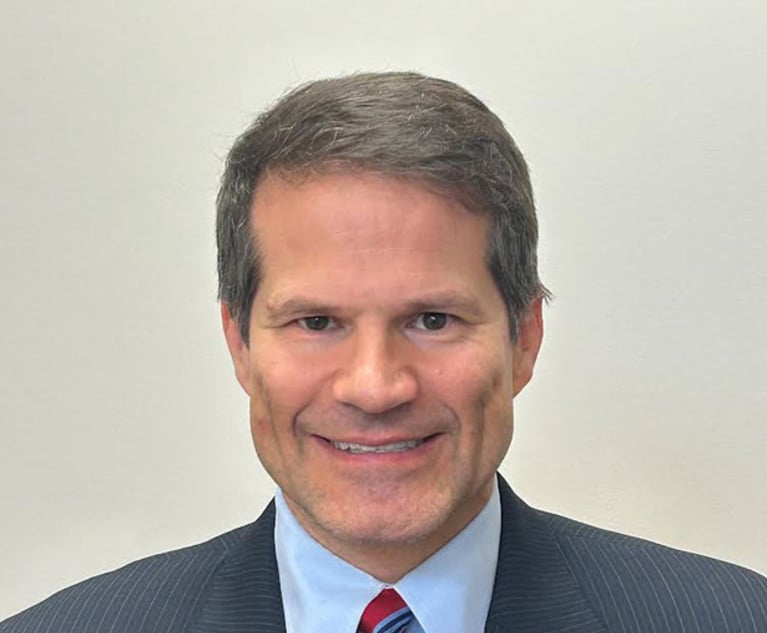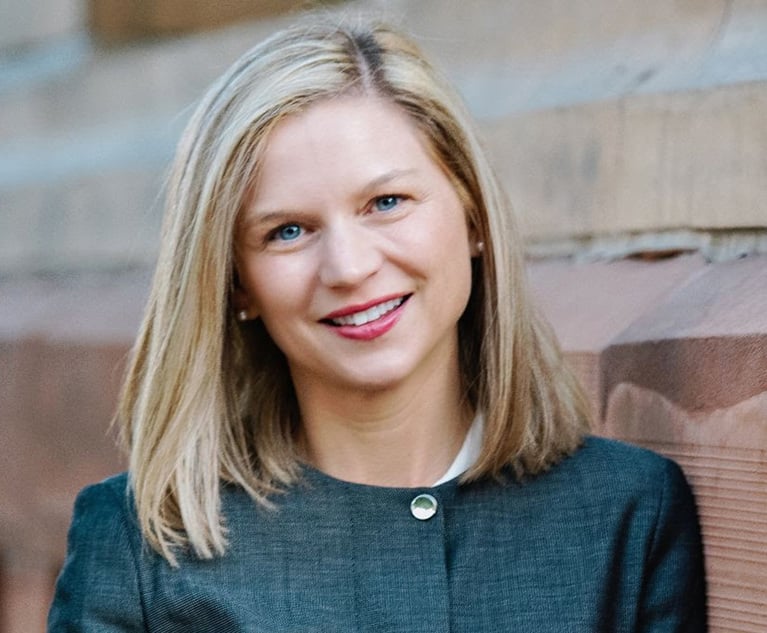 Consumer Financial Protection Bureau headquarters in Washington, D.C. Photo: Diego M. Radzinschi / ALM
Consumer Financial Protection Bureau headquarters in Washington, D.C. Photo: Diego M. Radzinschi / ALMJustices Fret About Sweep of Any Ruling Against Consumer Protection Bureau
Justice Sonia Sotomayor pushed back at Seila Law's lawyer, Kannon Shanmugam, who opened his argument with a claim that the CFPB's independent single-director structure was "unprecedented and unconstitutional."
March 03, 2020 at 12:23 PM
6 minute read
The fate of the Consumer Financial Protection Bureau appeared Tuesday to be in the hands of a U.S. Supreme Court struggling to define Congress' authority to limit a president's power to remove the director.
In the case Seila Law v. CFPB, which arrived from the U.S. Court of Appeals for the Ninth Circuit, the justices were asked two questions: Does the restriction on removing the bureau's director only "for cause" limit the power of the president to direct the executive branch? And if it does, can the removal provision be severed or must the entire law fall?
"There are at least two other [agencies], the Office of Special Counsel and the Social Security Administration, with single heads," Justice Sonia Sotomayor said at one point. "I see the Social Security Administration as more powerful than this agency. I don't think that this is so unprecedented as you claim."
Sotomayor was pushing back at Seila Law's lawyer, Kannon Shanmugam of Paul, Weiss, Rifkind, Wharton & Garrison, who opened his argument with a claim that the CFPB's independent structure was "unprecedented and unconstitutional."
Tuesday's arguments featured a trio of former clerks to the late Justice Antonin Scalia: Shanmugam; Paul Clement of Kirkland & Ellis; and Noel Francisco, the U.S. solicitor general. Clement was appointed to defend the bureau after the Trump Justice Department sided with Seila Law's challenge.
Throughout the quick-paced, 70-minute argument, the justices raised questions about the actual meaning of "for cause" removal and whether it was a weak or strong restraint on a president; whether multihead agencies posed a lesser threat to a president's authority than a single director, and if Congress could extend for-cause removal to cabinet officials.
"This is a very modest restraint which stops a president from removing someone at whim for someone who is loyal to the president instead of the consumers that Congress intended," Justice Ruth Bader Ginsburg told Shanmugam.
Shanmugam countered that for-cause removal "has never been read as 'modest.' Congress was trying to create an agency insulated from control."
Francisco, who agreed with Shanmugam that the for-cause removal provision violates the separation of powers, urged the justices—in disagreement with Shanmugam—to rule that the provision could be severed from the rest of the act creating the CFPB. He urged them not to extend their ruling in 1935 upholding that type of removal for multihead agencies to single-head agencies because that would be a "revolution" that could lead to for-cause removal of cabinet officials.
How the justices deal with the "severability" of the removal provision could provide hints of how they will approach a different and major severability issue next term involving the Affordable Care Act. The court will hear arguments on whether the individual mandate to have health insurance—deemed unconstitutional by the Fifth Circuit—can be separated from the rest of the health law or whether the entire law must fall.
Justice Brett Kavanaugh told Clement, who was defending the removal provision: "If you win, it's really the next president that faces the issue. The president may have a different concept of consumer protection and can do nothing about it."
But Clement said that was no different from the situation with other independent agencies, for example, the Federal Reserve. He said the court has held for decades that Congress can impose for-cause removal.
The Cato Institute's Ilya Shapiro, who attended Tuesday's arguments, said in a statement: "After a wide-ranging discussion of constitutional structure and executive power, the conventional wisdom holds: the Supreme Court will likely make the head of the CFPB removable at-will, but not otherwise change the agency. That would certainly be a start, but the constitutional defects with the agency's design remain."
|Complaints Since Its Creation
The CFPB has been a target of business criticism and legal challenges almost from its beginning. The outcome of the challenge is being closely watched not only for the fate of the consumer agency, but because of its potential significance for the future of the large number of independent agencies created by Congress.
Republican lawmakers and numerous business advocacy groups filed friend of the court briefs backing Seila law. Consumer advocates and Democrat-led states backed the independence of the agency.
Congress created the CFPB as part of the Dodd-Frank Wall Street Reform and Consumer Protection Act in 2010. The bureau can issue rules, conduct investigations and administrative enforcement proceedings and bring enforcement actions in federal court. The concept for the bureau was imagined and pushed by U.S. Sen. Elizabeth Warren, the Massachusetts Democrat and presidential contender.
 CFPB Director Kathy Kraninger testifies before the House Financial Services Committee. Photo: Diego M. Radzinschi /ALM
CFPB Director Kathy Kraninger testifies before the House Financial Services Committee. Photo: Diego M. Radzinschi /ALM
A single director appointed by the president and confirmed by the Senate heads the bureau and serves for a five-year term. The president can remove the director only "for cause," for example, "inefficiency, neglect of duty or malfeasance in office." Trump named Kathy Kraninger to lead the agency; she succeeded Richard Cordray, the Obama-era consumer bureau director.
The case at the Supreme Court stems from an investigation by the CFPB into Seila Law, a law firm in California that provides debt relief services, among other services. The bureau issued an investigative demand in 2017 for responses to interrogatories and document requests but the law firm refused to comply.
The CFPB sued Seila Law to enforce its demands. A federal district court ordered the law firm to comply. Seila Law appealed, arguing that the bureau lacked authority to issue its demand requests because the bureau's structure violated the Constitution's separation of powers. The constitutional problem, the law firm contended, was the for-cause removal restriction on the president, which encroached on his authority to direct executive branch operations.
The Ninth Circuit rejected Seila Law's arguments. The D.C. Circuit in an earlier opinion involving a different company, also upheld the bureau's constitutionality. In that case, PHH v. CFPB, Kavanaugh, then a judge on the appeals court, lambasted the "massive" and "unchecked" power of the agency's director.
This content has been archived. It is available through our partners, LexisNexis® and Bloomberg Law.
To view this content, please continue to their sites.
Not a Lexis Subscriber?
Subscribe Now
Not a Bloomberg Law Subscriber?
Subscribe Now
NOT FOR REPRINT
© 2024 ALM Global, LLC, All Rights Reserved. Request academic re-use from www.copyright.com. All other uses, submit a request to [email protected]. For more information visit Asset & Logo Licensing.
You Might Like
View All
Trump Picks Personal Criminal Defense Lawyers for Solicitor General, Deputy Attorney General


'Health Care Behemoth'?: DOJ Seeks Injunction Blocking $3.3B UnitedHealth Merger Proposal
3 minute read
Freshfields Hires DOJ Official, Squire Taps Paul Hastings Atty for US Antitrust Head
3 minute readLaw Firms Mentioned
Trending Stories
- 1How to Support Law Firm Profitability: Train Partners Up
- 2Elon Musk Names Microsoft, Calif. AG to Amended OpenAI Suit
- 3Trump’s Plan to Purge Democracy
- 4Baltimore City Govt., After Winning Opioid Jury Trial, Preparing to Demand an Additional $11B for Abatement Costs
- 5X Joins Legal Attack on California's New Deepfakes Law
Who Got The Work
Michael G. Bongiorno, Andrew Scott Dulberg and Elizabeth E. Driscoll from Wilmer Cutler Pickering Hale and Dorr have stepped in to represent Symbotic Inc., an A.I.-enabled technology platform that focuses on increasing supply chain efficiency, and other defendants in a pending shareholder derivative lawsuit. The case, filed Oct. 2 in Massachusetts District Court by the Brown Law Firm on behalf of Stephen Austen, accuses certain officers and directors of misleading investors in regard to Symbotic's potential for margin growth by failing to disclose that the company was not equipped to timely deploy its systems or manage expenses through project delays. The case, assigned to U.S. District Judge Nathaniel M. Gorton, is 1:24-cv-12522, Austen v. Cohen et al.
Who Got The Work
Edmund Polubinski and Marie Killmond of Davis Polk & Wardwell have entered appearances for data platform software development company MongoDB and other defendants in a pending shareholder derivative lawsuit. The action, filed Oct. 7 in New York Southern District Court by the Brown Law Firm, accuses the company's directors and/or officers of falsely expressing confidence in the company’s restructuring of its sales incentive plan and downplaying the severity of decreases in its upfront commitments. The case is 1:24-cv-07594, Roy v. Ittycheria et al.
Who Got The Work
Amy O. Bruchs and Kurt F. Ellison of Michael Best & Friedrich have entered appearances for Epic Systems Corp. in a pending employment discrimination lawsuit. The suit was filed Sept. 7 in Wisconsin Western District Court by Levine Eisberner LLC and Siri & Glimstad on behalf of a project manager who claims that he was wrongfully terminated after applying for a religious exemption to the defendant's COVID-19 vaccine mandate. The case, assigned to U.S. Magistrate Judge Anita Marie Boor, is 3:24-cv-00630, Secker, Nathan v. Epic Systems Corporation.
Who Got The Work
David X. Sullivan, Thomas J. Finn and Gregory A. Hall from McCarter & English have entered appearances for Sunrun Installation Services in a pending civil rights lawsuit. The complaint was filed Sept. 4 in Connecticut District Court by attorney Robert M. Berke on behalf of former employee George Edward Steins, who was arrested and charged with employing an unregistered home improvement salesperson. The complaint alleges that had Sunrun informed the Connecticut Department of Consumer Protection that the plaintiff's employment had ended in 2017 and that he no longer held Sunrun's home improvement contractor license, he would not have been hit with charges, which were dismissed in May 2024. The case, assigned to U.S. District Judge Jeffrey A. Meyer, is 3:24-cv-01423, Steins v. Sunrun, Inc. et al.
Who Got The Work
Greenberg Traurig shareholder Joshua L. Raskin has entered an appearance for boohoo.com UK Ltd. in a pending patent infringement lawsuit. The suit, filed Sept. 3 in Texas Eastern District Court by Rozier Hardt McDonough on behalf of Alto Dynamics, asserts five patents related to an online shopping platform. The case, assigned to U.S. District Judge Rodney Gilstrap, is 2:24-cv-00719, Alto Dynamics, LLC v. boohoo.com UK Limited.
Featured Firms
Law Offices of Gary Martin Hays & Associates, P.C.
(470) 294-1674
Law Offices of Mark E. Salomone
(857) 444-6468
Smith & Hassler
(713) 739-1250







